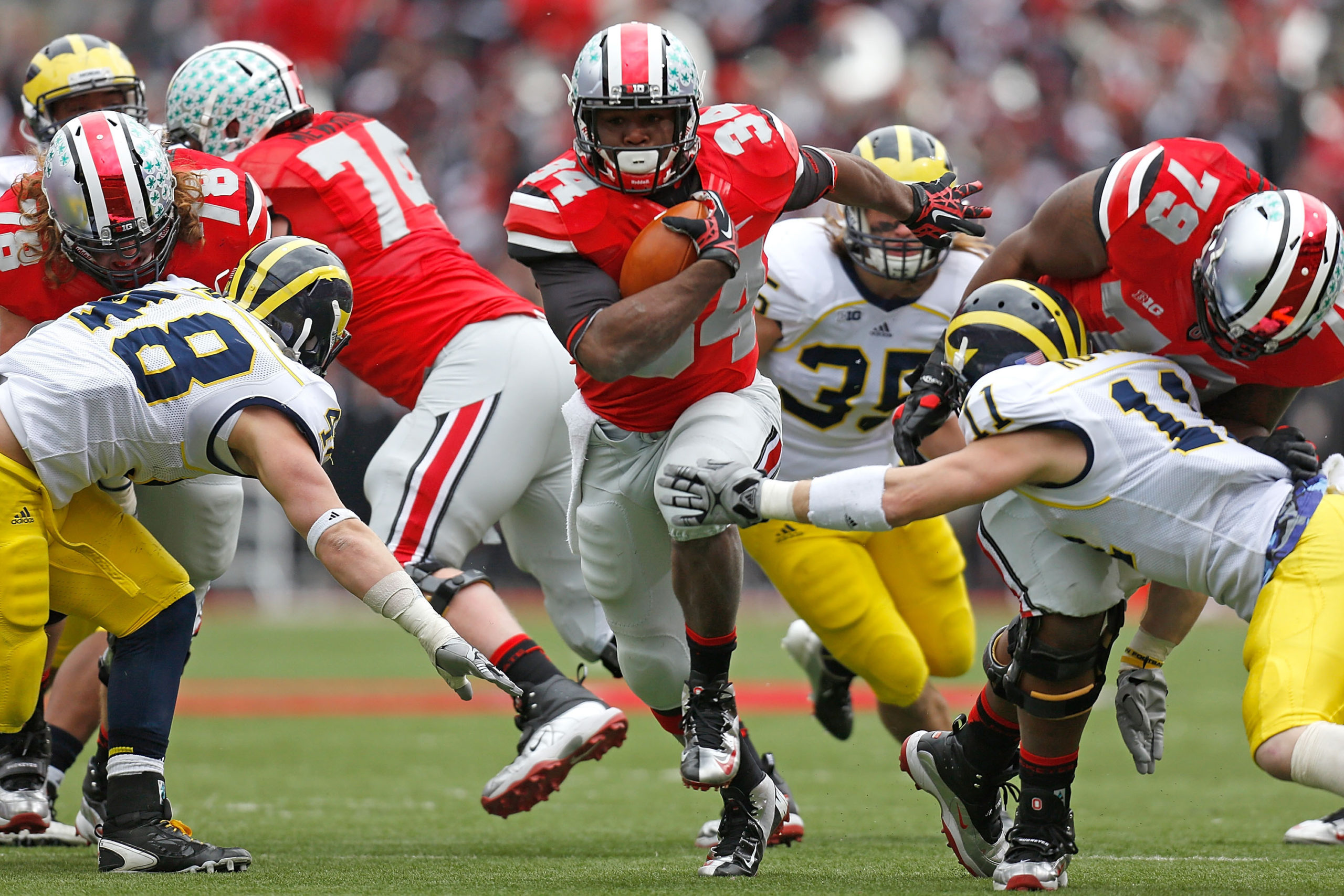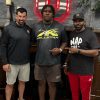
With the return of football up in the air, now serves as a perfect time for reflection on the history of football, and the strategic evolution of the game. To do that, the film study will be spending the offseason looking back at classic Ohio State games. Today’s film study takes a look at Ohio State’s 26-21 win over Michigan in 2012, and more specifically, Ohio State’s offense led by Braxton Miller. Video is from this cut-up. Last week’s film study can be found here. This is part one of two for this game.
This throwback film study is going to be a bit different than the other ones in the series, because there’s so much to talk about when it comes to Ohio State’s 2012 offense, and while the Michigan game is a great lens to do it through (primarily because of the availability of all-22 film), the game itself isn’t particularly interesting from a gameplanning perspective. Unlike a lot of games in the throwback film study, Ohio State’s in-game strategy and preparation in this game takes a back seat to the system itself.
The system, of course, was Urban Meyer and Tom Herman’s first offense together in Columbus. When Meyer walked into Columbus he had a few things that he knew he could lean on, even with a roster than had gone 6-7 the year prior, and he looked to build on those staples with the hire of Herman and the implementation of their offense.
Firstly, and most importantly, Meyer inherited Braxton Miller, the young quarterback that had flashed greatness as a freshman in 2011, even while serving in extremely difficult circumstances. Secondly, the Buckeyes returned Carlos Hyde, who looked to be the best of the bunch behind suspended Dan Herron in 2011. The rest of the offense – save for wideout Corey Brown and tight end Jake Stoneburner, who were awesome possession receivers and perimeter blockers that Miller could trust – was relatively unknown. The defense was the same story, and never really put it all together for Meyer’s first two years with OSU.
But, with Miller, Hyde, Brown and Stoneburner, Meyer knew he had a core to work with, and brought in Herman to build an offense around that group, while looking to minimize weakness on the offensive line and inexperience at receiver. What they produced was the foundation for what would become Ohio State’s most explosive offense of all time in 2013, led by a lethal option attack and the constant threat of a pass downfield to either Brown or Devin Smith, who developed into quite the deep threat as a sophomore.
In 2012, however, the offense never quite reached those heights. It was blatantly obvious that the potential was there though, and you can trace the success that Ohio State had in the years that followed right back to this first Meyer offense. Because of that, this throwback film study will be less about the game itself, and more about the offense that Ohio State was still growing into, and what it eventually became in 2013 and even beyond, when J.T. Barrett took over the reins in 2014.
As mentioned, there’s a lot to talk about. It’s an intricate and precise offense, and it deserves a deep dive that can really only be accomplished by breaking up the offense into parts and concepts, looking at how those concepts worked individually, and how they could have worked even better. Additionally, because there’s so much to talk about, there will be two parts: one for the running game, one for the passing game and quarterback rollouts, which are tied together.
THE RUN GAME
Ohio State’s strong suit in 2012 was its rushing attack, because even with improvements in his confidence and ability to read coverage, Miller was still much more comfortable with his legs than he was with his arm, and Ohio State had a much higher success rate and a much lower turnover rate when it simply kept the ball on the ground.
Herman’s run game was built primarily around zone blocking with option concepts tied to almost every play, so that Miller was always a threat to keep the ball. Ohio State loved to leave a defensive lineman unblocked to serve as the read for Miller in the backfield, both to get a numbers advantage with all five linemen able to focus on one fewer defender, but also to force the isolated defender to make a decision.
There are few things that college football defensive coordinators hate more than their defenders being forced to make a snap decision based only on what their eyes are telling them, and that’s exactly what Herman designed his offense around. No matter what was happening on the rest of the field, at least one defender was going to be in conflict, and if Miller made the right decision, the play was going to be successful.
You get to see this sort of concept very early, on Ohio State’s first drive of the game. Facing third down, Ohio State turns to a staple of its offense, a basic zone read. Everyone on the offensive line is blocking down with a reach block, isolating the defensive end, No. 88, and putting him into conflict with Miller looking to read him. With only five in the box outside of No. 88, Ohio State has now evened out the numbers by isolating the end, and with both players in the backfield serving as a threat to run, Michigan is now at a disadvantage, with too few guys in the box to handle whatever Miller decides to do.
The line pulls off their blocks well, freeing up the center to get second level and take on a linebacker. No. 88 holds outside to stop a quarterback keep, so Miller tucks the ball right into Hyde’s arms, making sure to really sell the handoff to keep that defensive end right where he is until Hyde is able to get going downfield. The read is correct, and even with some lackluster blocking that nearly blows up the play before Hyde can hit his gap, an arm tackle isn’t enough to stop the powerful back, giving Ohio State an easy first down.
You can think of this as Ohio State’s base running play, with variations tied on to it to keep the defense on its heels. It’s an easy play to run, an easy read for Miller, and it has a very high success rate as long as Michigan doesn’t load up the box.
Still, even though the Buckeyes loved this play and a had a ton of success running it all year, it’s easy to see that Miller wasn’t fully comfortable with it yet, and became a lot better at running it as a junior in 2013. Later in the game, Ohio State shows this look again, bringing in a tight end to help with the extra Michigan defender in the box, but this time, Miller doesn’t quite do his job. The blocking up front is decent, but Michigan is loading up the box, which Miller should have noted before the play.
With six players inside looking to stop the handoff, anything short of perfect blocking is going to lead to a minimal gain, as it does here. In 2013, a more experienced Miller sees this, and makes sure to really drag out the handoff, forcing No. 97 even further inside, giving Miller the edge to the outside so that he can pull the ball and look to win a one-on-one matchup with a much slower player. In 2012, however, Miller panics at the pressure that Michigan is showing, gives the ball off to quickly, and takes himself out of the play.
Against Illinois in 2013, you see that sort of growth in Miller on this play, almost the exact same situation as this one. Instead of forcing the handoff into a loaded box, Miller really pressures that end, and even when he doesn’t really budge, Miller is more confident to pull the ball and make a play himself. It’s counter intuitive to encourage your quarterback to take the ball out of his halfback’s hands, but in Miller’s case, it was often the right thing to do on plays like these, and he didn’t really learn that until his junior campaign.
While the zone read was a big part of Ohio State’s rushing attack, and while it served as a the base for a lot of what Ohio State was doing, it’s far from the only concept that the Buckeyes had success with. Firstly, it had quite a few variations that Ohio State was able to have success with, starting with this, which pulls from both the option game and from classic power running adding a pulling guard into the mix to really overload the middle of the defense.
This was much more of a true halfback run concept for the Buckeyes, as it didn’t even have an isolation defender attached to it. With six blockers to match Michigan’s six defenders in the box, Ohio State is just looking to get a hat on a hat up front, while freeing up that pulling guard to make a play downfield to spring Hyde. The right tackle is sealing off the end, the center is reaching to take on the tackle that was head up on the pulling guard, and the playside guard and tackle are looking to double the other tackle and push him into the backside linebacker, with the tight end face up on the other end.
Ohio State blocks it perfectly, No. 79 shows off great athleticism to pick up a downfield block, and Hyde is open for a big run. This has less big play potential that the true read option, but it works consistently.
Lastly in the zone read family(that will be featured in this study, at least), Ohio State occasionally used a counter look.
There’s nothing too complex happening here, just an extra counter action in the backfield to try to hold those linebackers in place as Ohio State tries to sell a Miller rollout (more on those in part two). With the counter, the linemen have more time to set up, which they need, because OSU is pulling a guard across to take on the unblocked play side defensive end, as well as a tight end to try to clean up and seal a linebacker on the second level. It doesn’t work very well here because the linebackers aren’t really convinced by Miller’s fake (or lack thereof), but it’s still a cool play, especially when you add in the rest of the playbook.
Now, it wasn’t all zone read for Ohio State, and you can’t really talk about Ohio State’s offense under Meyer without talking about his crowning achievement, the modernized inverted veer, one of the most brilliant offensive innovations of the last decade.
This is, put simply, brilliant. It’s a perfect play, and one that Meyer used constantly at Ohio State, especially when he had an athlete like Miller running the show. It’s an inverted (hence the name) version of the traditional read option, with the halfback serving as the outside threat, while the quarterback is looking to run right up the middle if he keeps, rather than the other way around that you see on those usual zone read looks.
The inversion allowed Ohio State to isolate both ends (as it does here) or tackles. The latter is rarely isolated in a modern offense, and when they are, it usually freaks them out so much that they completely forget how to play football. Here, Ohio State keeps it simple and isolated No. 88 again, this with Miller looking to hand the ball off if he slides too far inside, while the line is running that same reach block scheme. No. 88 plays it conservative, Miller hands off, and with a tight end and receivers helping on the outside, Hyde has all sorts of open space to make a play.
There were variations on this concept as well, including an added guard pull and the inclusion of an H-back, both of which you see here. With seven defenders in the box and an eighth in the form of that safety poking around on the edge, Ohio State has to get creative to even up the numbers here, and does so by bringing Brown into the fold to use as the halfback on the veer. With a tight end on the line and Hyde now serving as a lead blocker, Ohio State has seven to match Michigan’s seven.
Miller is reading No. 88, while the tight end rubs right around him to cut down the linebacker in the case of a handoff to Brown. Hyde looks to get downfield for a second level-block, as does the pulling backside guard. Everything else is about the same as it was on that earlier trap look, with the playside guard and tackle doubling to block into the backside linebacker, while the pulling guard is aiming for the middle linebacker. Miller makes the end look absolutely foolish with a brilliant handoff.
Hyde’s block downfield is great, the tight end completely takes out the middle linebacker, and because everyone else does such a great job, that pulling guard is into the third level untouched. If he’s a step faster and able to take on that safety, Brown takes this one to the house untouched. Even though he’s eventually tripped up, this is just phenomenal stuff from Meyer and Herman, with the kind of innovative option thinking that would make Woody Hayes blush.
Stay tuned for part two of the film study of this game, which will focus on Ohio State’s growing passing attack and how the Buckeyes used quarterback rollouts to help Miller read the defense.








